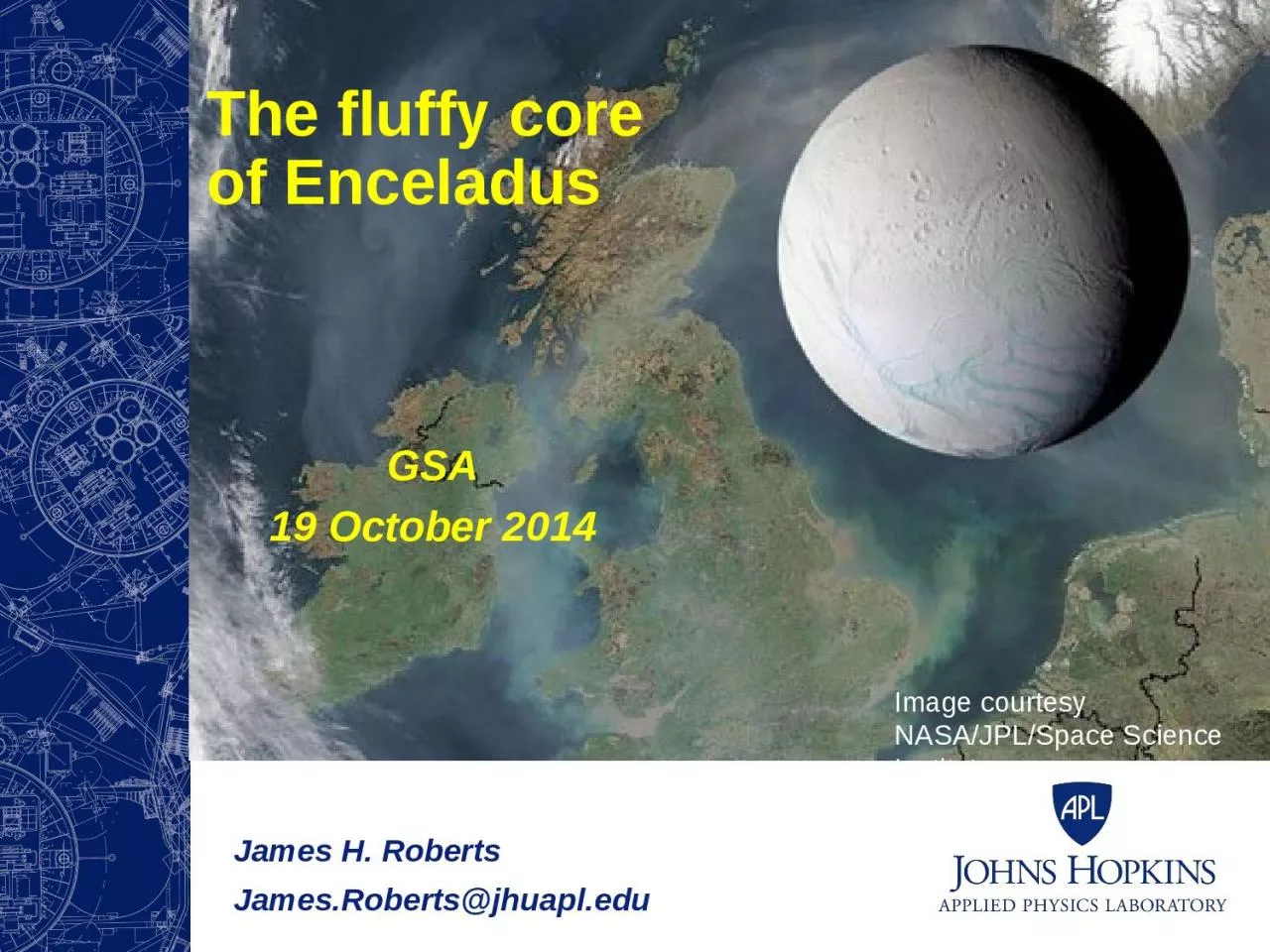

GSA 19 October 2014 James H Roberts JamesRobertsjhuapledu Image courtesy NASAJPLSpace Science Institute Spencer et al Science 2006 Tiger Stripes The south polar region 516 GW 70 200 mW m ID: 1022242
Download Presentation The PPT/PDF document "The fluffy core of Enceladus" is the property of its rightful owner. Permission is granted to download and print the materials on this web site for personal, non-commercial use only, and to display it on your personal computer provided you do not modify the materials and that you retain all copyright notices contained in the materials. By downloading content from our website, you accept the terms of this agreement.
1. The fluffy core of EnceladusGSA19 October 2014James H. RobertsJames.Roberts@jhuapl.eduImage courtesy NASA/JPL/Space Science Institute
2. Spencer et al. Science 2006Tiger StripesThe south polar region5-16 GW (70 - 200 mW m-2) heat flow in S. polar region (Howett et al. 2011; 2013)Roughly 10X long-term sustainable level (Meyer and Wisdom, 2007)35 kmPorco et al. Science 2006South Polar Plume
3. Classic ModelEnceladus has a differentiated interior (Schubert et al., 2007)Eccentric orbit about Saturn causes time-varying tidal forcesRocky core too rigid for substantial deformationAn ocean decouples ice shell from core, allowing deformation of the iceTidal energy dissipated as heat
4. The Ocean: A Cost-Benefit AnalysisDecouples ice shell from the silicate coreAllows ice shell to deform tidallyIt may not last longPure water ocean freezes in tens of MyCan freezing can be inhibited?Roberts and Nimmo, (2008), Icarus
5. Regional SeaA regional sea (e.g., at the south pole; Collins and Goodman, 2007) Consistent with gravity measurements (Iess et al., 2014)Can survive more easily than a global ocean (Tobie et al., 2008)Somewhat restrictive size range Seas spanning on order 120˚ of arc surviveTobie et al. (2008), Icarus
6. AntifreezeNH3, various salts depress the melting pointPossibly by 100 KSlows down the freezing rateMay be able to prevent freezing altogetherMcKinnon and Barr (2008; 2013)How much NH3 is in the ocean?What does this do to the rheology?Merkel & Bošnjaković (1929)
7. Ammonia reduces buoyancy of iceIncreased NH3 reduces density of fluidSolutions >15% NH3 are less dense than Ice IFreezing point cannot be lower than ~230 KIce IOcean
8. Do we even need the ocean?Without it, the core prevents the ice from movingThe core is really the culpritThe coupling wouldn’t matter so much if the core weren’t so rigid
9. An Alternative ViewIs the core consolidated?Formation > 1.6 My after CAIs precludes melting of silicatesCentral Pressure ~20 MPaRubble-pile core filled interstitial water or ice.Core temperature always below brittle-ductile transition (Neveu et al., 2014)
10. Tidal DissipationAssume Enceladus is differentiated and frozenCore contains 0 – 30% of ice-filled porosityLower limit: Core is monolithic, behaves as rockUpper limit: Rock fragments no longer in contact, ice controls deformationCompute tidal heating in various model EnceladiTiRADE (Roberts and Nimmo, 2008)Tidal Response And Dissipaton of EnergySolve for tidal stress and strain in a multilayered visco-elastic bodyCore rigidity and viscosity are a weighted log average of ice and rock values.
11. Tidally-generated HeatSignificant dissipation in core if porosity > 20 %At 30% porosity, dissipate 1.7 GWMostly in core!Factor of 20 change in heating between end-member models
12. SerpentinizationDisaggregated core water-rock interaction, even at great depth (Neveu et al., 2014)Example: 2Mg2SiO4 + 3H2O → Mg3Si2O5(OH)4 + Mg(OH)2Substantial reduction in densityr = 2.6 g cm-3 (vs. 3.3 g cm-3 for unserp. silicates)Serpentinized core is compatible with gravity measurements (Iess et al., 2014) that suggest a low density coreC/MR2 = 0.335Weakens core substantiallym = 35 GPa (vs. 70-100 GPa)h = 4*1019 Pa s (vs. > 1020 Pa s)
13. Tidally-generated Heat in Serpentinized CoreHeating doubles in a serpentinized competent coreFew % increase in ice layer
14. Tidally-generated Heat in Serpentinized CoreCore dissipation becomes effective at slightly lower porosities~ 10% increase in heating overall
15. Distribution of Tidal HeatState of the core controls the pattern of heatingRigid coreMaximum heating at mid-latitudesMinimum heating at polesWeak coreMaximum heating at polesMinimum heating at sub-Saturn, anti-Saturn pointsAlso what you get with an oceanCurrent Enceladus looks more like the bottomMonolithic coreUnconsolidated core
16. ImplicationsEnceladus may be tidally heated, even when completely frozenSilicate core unconsolidated, lubricated by interstitial iceSerpentinized silicates more deformableHeating rates ~10% of observed heat flowConsistent with the long-term sustainable level of tidal dissipation (Meyer and Wisdom, 2007) Heat may be produced at this lower rate, and episodically released at the higher observed rate (O’Neill and Nimmo, 2010)An ocean is not required in order to explain observed activity on EnceladusNor is it precluded
17. However…How does mechanical behavior of core depend on ice fraction?Can dissipation in core re-melt ocean?Will the ice stay warm?
18. Thermal EvolutionModel thermal evolution in ice shell and coreCitcom in layered sphere (2D axisymmetric)Radioactive heating in silicate-bearing coreInsulating bottom boundaryTiRADE and Citcom coupled using BFI techniqueBrute Force and IgnoranceCompute viscosity based on initial temperature profileCompute tidal heating (TiRADE)Ingest heating into thermal modelEvolve temperature and viscosity for short time (Citcom)Update tidal heating based on new viscosity (TiRADE)Repeat as necessary
19. Convective interior
20. Almost melting!
21. Enhanced heating
22. ConclusionsA frozen Enceladus may be tidally heated even with no subsurface oceanIF: The core is unconsolidated and weakAND: The ice remains relatively warmThe core is probably fluffy (and highly serpentinized)The ice will not stay warm without an oceanOcean required to sustain thermal activity Must be present initiallyCannot form later without additional heat sourceDissipation important in coreAnd maybe the ocean? (Tyler, 2009, 2011; Matsuyama, 2014, in press)This work funded by NASA’s Outer Planets Research Program
23.
24. Initially cold interior